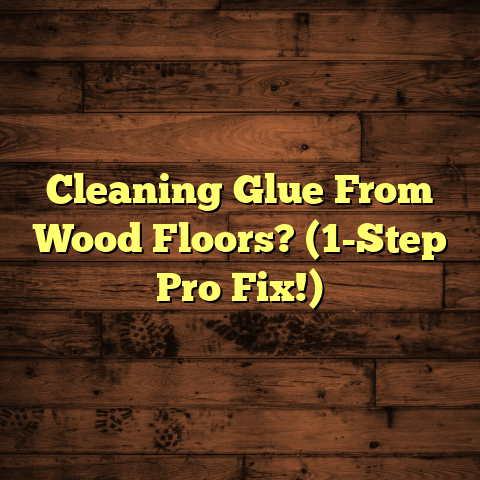Cleaning Porcelain Tile Floors (1 Wrong Cleaner!)
I’m Mark, and I’ve been a flooring contractor for over 20 years. I’ve seen it all, trust me.
From stunning transformations to absolute disasters.
And one of the most common issues I see? Folks using the wrong cleaner on their beautiful porcelain tile floors.
It’s heartbreaking because porcelain tile is incredibly durable and easy to care for… if you know what you’re doing.
Imagine this: You spend your Saturday scrubbing, thinking you’re doing a great job, only to find streaks, dullness, or even damage staring back at you.
Ugh, the worst, right?
That’s why I’m writing this article – to help you avoid that cleaning nightmare. Let’s dive deep into the world of porcelain tile cleaning and figure out how to keep your floors looking fantastic for years to come.
1. Understanding Porcelain Tiles
So, what exactly is porcelain tile? It’s not just another type of ceramic.
Porcelain is a specific type of ceramic tile made from a refined clay mixture and fired at extremely high temperatures. This process makes it incredibly dense, hard, and less porous than other ceramic tiles.
Think of it like this:
| Feature | Porcelain Tile | Ceramic Tile |
|---|---|---|
| Water Absorption | Less than 0.5% | More than 0.5% |
| Density | High | Medium |
| Durability | Very High | High |
Because of these properties, porcelain tile is super resistant to water, stains, scratches, and even frost. That’s why you see it everywhere – bathrooms, kitchens, hallways, and even outdoor patios.
The Popularity of Porcelain Tiles
in Modern Homes
Why is porcelain so popular? Well, a few reasons:
- Durability: It can withstand heavy foot traffic without showing wear and tear.
- Low Maintenance: As you’ll see, cleaning is usually a breeze (if you use the right stuff!).
- Design Versatility: Porcelain tiles come in a massive range of colors, sizes, and styles. You can even find tiles that look like wood or natural stone!
- Water Resistance: Perfect for areas prone to moisture.
- Longevity: With proper care, porcelain tile can last for decades.
I’ve seen homes where porcelain tiles still look brand new after 20+ years.
Benefits of Porcelain Tiles Over
Other Flooring Options
Compared to other flooring materials like hardwood, carpet, or vinyl, porcelain tile offers some serious advantages:
- Hardwood: Beautiful, but susceptible to water damage and scratches. Requires refinishing.
- Carpet: Comfortable, but traps dirt, allergens, and stains easily. Needs regular professional cleaning.
- Vinyl: Affordable, but less durable and can be easily damaged.
- Natural Stone (Marble, Granite): High-end look, but often requires sealing and special cleaning products. Can be porous and stain easily.
Porcelain strikes a great balance between aesthetics, durability, and ease of maintenance.
2. Common Cleaning Methods for Porcelain Tiles
Okay, now let’s talk cleaning. There are tons of ways to tackle those porcelain tiles.
Overview of Traditional Cleaning Methods
The basics usually involve:
- Sweeping or Vacuuming: Removing loose dirt and debris.
- Mopping: Using a wet mop and a cleaning solution to remove surface stains and grime.
- Rinsing: Removing any cleaner residue with clean water.
- Drying: Allowing the floor to air dry or using a clean towel.
I remember my grandma just used a simple bucket of hot water and a bit of dish soap. While that can work in some cases, it’s not always the best approach.
The Emergence of Advanced Cleaning Technologies
We’ve come a long way from buckets and mops! Now we have:
- Steam Mops: Use hot steam to sanitize and clean without chemicals.
- Spin Mops: Feature a spinning mop head for efficient cleaning and wringing.
- Robotic Mops: Autonomous devices that can be programmed to clean your floors on a regular schedule.
These technologies can definitely make cleaning easier and more efficient, but they still rely on using the right cleaning solutions.
Popular DIY Cleaners and Their Effectiveness
Ah, DIY cleaners! Everyone loves a good home remedy. I’ve heard them all:
- Vinegar and Water: A classic for general cleaning.
- Baking Soda Paste: For tackling stubborn stains.
- Lemon Juice: For brightening and disinfecting.
While some DIY cleaners can be effective, they’re not always the best choice for porcelain tile.
Vinegar, for example, is acidic and can etch certain types of tile grout over time. Baking soda can be abrasive and scratch the surface if you’re not careful.
3. The Importance of Choosing the Right Cleaner
This is where things get serious. Choosing the right cleaner is crucial for maintaining the beauty and longevity of your porcelain tile floors.
The Role of pH Balance in Cleaning Products
pH is a measure of how acidic or alkaline a substance is. It ranges from 0 to 14, with 7 being neutral.
- Acidic Cleaners (pH < 7): Good for removing hard water stains and mineral deposits.
- Alkaline Cleaners (pH > 7): Good for removing grease and oily soils.
- Neutral Cleaners (pH = 7): Generally safe for most surfaces and good for everyday cleaning.
For porcelain tile, a neutral pH cleaner is usually the safest bet. Highly acidic or alkaline cleaners can damage the grout and potentially dull the tile surface over time.
How Cleaning Agents Interact
with Porcelain Surfaces
Porcelain tile is non-porous, meaning it doesn’t absorb liquids easily. However, the grout between the tiles is porous and can absorb cleaning solutions.
Harsh chemicals can break down the sealant on the grout, leading to discoloration, staining, and even crumbling.
I’ve seen grout lines completely destroyed by people using the wrong cleaners. It’s not a pretty sight.
Common Misconceptions About
Cleaning Porcelain Tiles
Let’s bust some myths:
- “All-purpose cleaners are safe for all surfaces.” Nope! Some all-purpose cleaners contain harsh chemicals that can damage porcelain tile and grout.
- “More cleaner is better.” Wrong! Using too much cleaner can leave a sticky residue that attracts dirt and dulls the surface.
- “If it smells clean, it is clean.” Not necessarily! The scent of a cleaner doesn’t always indicate its effectiveness or safety.
4. The Dangers of Using the Wrong Cleaner
Now for the scary part – what can happen if you use the wrong cleaner?
Case Studies of Damage Caused by
Inappropriate Cleaners
I’ve got a few stories for you:
- The Vinegar Disaster: A homeowner used a strong vinegar solution to clean their porcelain tile kitchen floor. Over time, the grout started to crumble and discolor. They had to spend thousands of dollars to regrout the entire floor.
- The Bleach Blunder: A homeowner used bleach to try to remove a stain on their porcelain tile bathroom floor. The bleach not only failed to remove the stain but also discolored the grout and left a chalky residue on the tile surface.
- The Abrasive Nightmare: A homeowner used an abrasive scouring powder to clean their porcelain tile entryway. The powder scratched the surface of the tile, leaving it dull and unsightly.
These are just a few examples of the damage that can be caused by using the wrong cleaners.
Symptoms of Damage: Discoloration,
Etching, and Loss of Shine
How can you tell if you’ve damaged your porcelain tile floors? Look for these signs:
- Discoloration: Fading or changes in the color of the tile or grout.
- Etching: Dull, cloudy spots on the tile surface.
- Loss of Shine: A general dullness or lack of luster.
- Cracked or Crumbling Grout: Grout that is breaking down or falling apart.
- Sticky Residue: A film or coating on the tile surface that attracts dirt.
If you notice any of these symptoms, stop using the cleaner immediately and consult with a flooring professional.
Long-Term Effects of Repeated Use of
Harsh Chemicals
Even if you don’t see immediate damage, repeated use of harsh chemicals can have long-term consequences.
Over time, these chemicals can weaken the tile’s surface, making it more susceptible to staining and scratching. They can also damage the grout, leading to costly repairs.
5. Spotlight on the One Wrong Cleaner
Okay, let’s get to the heart of the matter. What’s the one cleaner you should absolutely avoid using on your porcelain tile floors?
While there isn’t one single cleaner that’s universally bad for all porcelain tiles, there’s a category of cleaners that I see causing problems way more often than others:
Acidic Cleaners Containing Hydrofluoric Acid (HF)
Identifying the One Cleaner That Has
Potential to Harm
Hydrofluoric acid is a very strong acid used in some tile and grout cleaners, especially those designed for removing stubborn mineral deposits, rust stains, or hard water buildup.
You might find it in products marketed as “tile and grout restorers” or “acid wash” solutions. Always read the label carefully!
The Chemical Composition of This
Cleaner and Why It’s Harmful
HF is incredibly corrosive. It doesn’t just sit on the surface; it penetrates deep into the tile and grout, reacting with the minerals and causing irreversible damage.
Here’s why it’s so bad:
- Etching: HF dissolves the glaze on porcelain tile, leaving it dull and prone to staining.
- Grout Destruction: HF attacks the cement in grout, causing it to crumble and disintegrate.
- Safety Hazard: HF is extremely dangerous to handle. It can cause severe burns and respiratory problems.
Even diluted solutions of HF can be harmful. It’s simply not worth the risk.
Real-Life Testimonials from Homeowners
Affected by This Cleaner
I’ve spoken to countless homeowners who regret using HF-based cleaners on their porcelain tile floors.
One woman told me she used an HF cleaner to remove some rust stains in her bathroom. The stains disappeared, but so did the shine on her tiles. Now her bathroom floor looks permanently dull and lifeless.
Another homeowner used an HF cleaner to try to remove hard water stains from their shower tiles. The cleaner ate away at the grout, leaving it cracked and crumbling. They had to hire a professional to regrout the entire shower.
The lesson? Steer clear of HF cleaners!
6. Best Practices for Cleaning Porcelain Tile Floors
Alright, now that we know what not to do, let’s talk about the right way to clean your porcelain tile floors.
Recommended Cleaning Products
and Their Benefits
- Neutral pH Cleaners: These are your best bet for everyday cleaning. Look for products specifically designed for tile and grout.
- Steam Mops: A great chemical-free option for sanitizing and cleaning.
- Enzyme Cleaners: Effective for removing organic stains like pet messes or food spills.
I personally recommend using a neutral pH cleaner and a microfiber mop for routine cleaning. It’s simple, effective, and safe for your floors.
Step-by-Step Guide to Cleaning
Porcelain Tile Floors Effectively
- Sweep or Vacuum: Remove loose dirt and debris.
- Prepare Your Cleaning Solution: Dilute your neutral pH cleaner according to the manufacturer’s instructions.
- Mop the Floor: Use a clean microfiber mop to apply the cleaning solution to the floor.
- Rinse (Optional): If you’re using a cleaner that leaves a residue, rinse the floor with clean water.
- Dry: Allow the floor to air dry or use a clean towel to dry it.
Maintenance Tips to Prolong the Life
and Beauty of Your Tiles
- Clean Up Spills Immediately: Don’t let spills sit on the floor for extended periods.
- Use Doormats: Place doormats at entrances to trap dirt and debris.
- Regular Sweeping or Vacuuming: Prevents dirt from accumulating and scratching the tile surface.
- Consider Sealing Your Grout: Sealing the grout helps protect it from staining and makes it easier to clean.
7. Conclusion: Making Informed Cleaning Choices
We’ve covered a lot of ground here. Let’s recap the key takeaways:
Recap of the Importance of Selecting
the Right Cleaner
Choosing the right cleaner is essential for maintaining the beauty and longevity of your porcelain tile floors. Avoid harsh chemicals like hydrofluoric acid, and stick to neutral pH cleaners for everyday cleaning.
Final Thoughts on Maintaining the
Beauty of Porcelain Tile Floors
Porcelain tile is a fantastic flooring option that can last for decades with proper care. By following the tips and advice in this article, you can keep your floors looking their best for years to come.
Encouragement for Readers to Share
Their Experiences and Tips
Now, I’d love to hear from you! What are your favorite cleaning products and techniques for porcelain tile floors? Share your experiences and tips in the comments below.
Let’s learn from each other and keep those floors sparkling!





